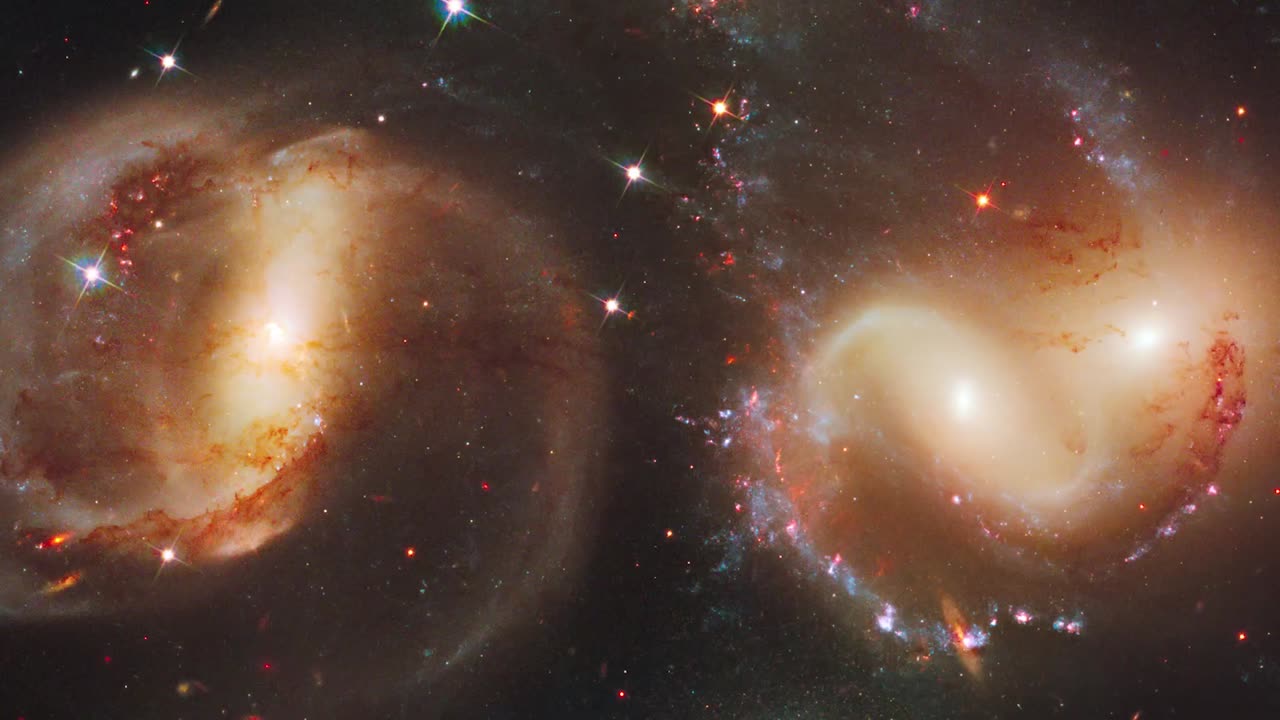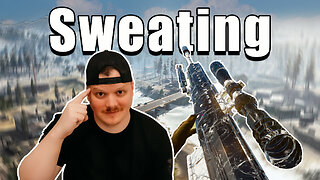Premium Only Content

Hubble’s Inside the Image: Stephan's Quintet
NASA's Hubble Space Telescope has captured an extraordinary image of Stephan's Quintet, a visual grouping of five galaxies that offers a unique glimpse into the dynamics of galaxy interactions.
In this video, Dr. Jennifer Wiseman explores the intricate details of Stephan's Quintet and discusses how Hubble's observations continue to deepen our understanding of galactic behavior and the universe as a whole.
For more information, visit https://nasa.gov/hubble.
Credit: NASA's Goddard Space Flight Center
Producer, Director & Editor: James Leigh
Director of Photography: James Ball
Executive Producers: James Leigh & Matthew Duncan
Production & Post: Origin Films
Video Credits:
Hubble Space Telescope Animation:
ESA/Hubble - M. Kornmesser & L. L. Christensen
Stephan's Quintet Visualization:
NASA, ESA, and G. Bacon, J. DePasquale, F. Summers, and Z. Levay (STScI)
Music Credits:
"Transcode" by Lee Groves [PRS], and Peter George Marett [PRS] via Universal Production Music
"Perennial Ice" by Matthew Nicholson [PRS], and Suki Jeanette Finn [PRS] via Atmosphere Music Ltd. [PRS] and Universal Production Music
This video can be freely shared and downloaded at https://svs.gsfc.nasa.gov/14670. While the video in its entirety can be shared without permission, the music and some individual imagery may have been obtained through permission and may not be excised or remixed in other products. Specific details on such imagery may be found here: https://svs.gsfc.nasa.gov/14670. For more information on NASA’s media guidelines, visit https://www.nasa.gov/multimedia/guide....
Tr0:07
This is a group
0:07
of galaxies known as Stephan's Quintet.
0:11
Quintet meaning five, of course.
0:13
And you can see them here.
0:14
One, two, three, four, five.
0:18
Although, it's really just a visual quintet because it turns out that
0:21
the galaxy here on the left is a lot closer than the other four.
0:26
The other four are at a distance of about 290 million light years away.
0:31
And the nearby one is only about 40 million light years away.
0:35
You can also see its difference in color and details.
0:39
They're still all in our deep universe.
0:41
And they make for a very interesting picture.
0:47
The ones on the right
0:48
are actually gravitationally interacting with each other.
0:52
They are feeling each other's pull,
0:54
and that's creating structural changes in these galaxies.
0:58
You can even see evidence that the spiral structure in these galaxies is becoming
1:03
distorted as they feel each other's gravitational tug.
1:07
It's creating long tails of stars and star formation between the galaxies.
1:12
Because as you have more regions where gas is stirred up and compacted,
1:16
that's the recipe for more clumps of gas in
1:19
each of these galaxies to collapse and form more stars.
1:23
You can see these two are closer in this dance of merging.
1:27
And all of this is evidence of the merging process of galaxies
1:31
that we now know is very common in the history of our universe.
1:35
Galaxies that are close enough to each other will feel each other's
1:38
gravitational pull.
1:40
They'll come toward each other.
1:41
that creates a little dance as they orbit around each other, sometimes
1:45
go through each other and they distort each other structure.
1:49
So you can see this cosmic dance going on right now
1:52
in Stephan's Quintet, and you can see some of the impacts of that.
1:59
So we
2:00
can see that the galaxies are connected to each other.
2:03
Now and they're showing us that merging is an important part
2:07
of forming structure in stars and galaxies.
2:10
We actually believe
2:11
that most galaxies have gone through at least one merger in cosmic history.
2:16
We believe our Milky Way has and will again.
2:20
So we want to watch this dramatic dance so that we understand how galaxies
2:24
have formed and grown over cosmic history, including our own Milky Way.
tanscript
0:07
This is a group
0:07
of galaxies known as Stephan's Quintet.
0:11
Quintet meaning five, of course.
0:13
And you can see them here.
0:14
One, two, three, four, five.
0:18
Although, it's really just a visual quintet because it turns out that
0:21
the galaxy here on the left is a lot closer than the other four.
0:26
The other four are at a distance of about 290 million light years away.
0:31
And the nearby one is only about 40 million light years away.
0:35
You can also see its difference in color and details.
0:39
They're still all in our deep universe.
0:41
And they make for a very interesting picture.
0:47
The ones on the right
0:48
are actually gravitationally interacting with each other.
0:52
They are feeling each other's pull,
0:54
and that's creating structural changes in these galaxies.
0:58
You can even see evidence that the spiral structure in these galaxies is becoming
1:03
distorted as they feel each other's gravitational tug.
1:07
It's creating long tails of stars and star formation between the galaxies.
1:12
Because as you have more regions where gas is stirred up and compacted,
1:16
that's the recipe for more clumps of gas in
1:19
each of these galaxies to collapse and form more stars.
1:23
You can see these two are closer in this dance of merging.
1:27
And all of this is evidence of the merging process of galaxies
1:31
that we now know is very common in the history of our universe.
1:35
Galaxies that are close enough to each other will feel each other's
1:38
gravitational pull.
1:40
They'll come toward each other.
1:41
that creates a little dance as they orbit around each other, sometimes
1:45
go through each other and they distort each other structure.
1:49
So you can see this cosmic dance going on right now
1:52
in Stephan's Quintet, and you can see some of the impacts of that.
1:59
So we
2:00
can see that the galaxies are connected to each other.
2:03
Now and they're showing us that merging is an important part
2:07
of forming structure in stars and galaxies.
2:10
We actually believe
2:11
that most galaxies have gone through at least one merger in cosmic history.
2:16
We believe our Milky Way has and will again.
2:20
So we want to watch this dramatic dance so that we understand how galaxies
2:24
have formed and grown over cosmic history, including our own Milky Way.
-
 2:40:59
2:40:59
BlackDiamondGunsandGear
6 hours agoITS MA'AM!! / After Hours Armory / Are you threatening me?
18.3K4 -
 44:54
44:54
SouthernbelleReacts
8 days ago $1.12 earnedHIS RUG… I CAN’T STOP LAUGHING 🤣 | Big Lebowski Reaction
12.1K8 -
 2:17:46
2:17:46
megimu32
5 hours agoOFF THE SUBJECT: Reddit Meltdowns, Music Takes & Bodycam Breakdowns
40.4K12 -
 LIVE
LIVE
The Rabble Wrangler
11 hours agoRedSec with Mrs. Movies | The Best in the West Carries His Wife to Victory!
258 watching -
 2:40:59
2:40:59
DLDAfterDark
4 hours ago $4.64 earnedTrans Man's Death Threats To Christian Conservatives - Whistlin' Diesel Tax Evasion
23.3K3 -
 23:42
23:42
Robbi On The Record
2 days ago $7.00 earnedWhat's happening in the republican party?? BTS of Michael Carbonara for Congress
63.3K12 -
 4:53
4:53
PistonPop-TV
2 days ago $2.44 earnedThe G13B: The Tiny Suzuki Engine That Revved Like Crazy
13.1K1 -
 5:55:29
5:55:29
GritsGG
7 hours ago#1 Most Warzone Wins 4000+!
26.3K2 -
 1:58:31
1:58:31
Joker Effect
5 hours agoSTREAMER NEWS: WHAT IS JOKER DOING?! Where is the streamer space going now?! Q & A
15.1K3 -
 LIVE
LIVE
Eternal_Spartan
8 hours ago🟢 Eternal Spartan Plays Arc Raiders - New Updates! | USMC Veteran
99 watching